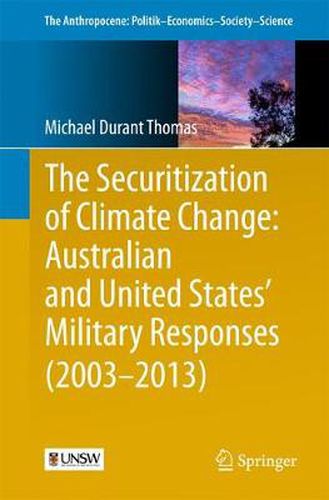Readings Newsletter
Become a Readings Member to make your shopping experience even easier.
Sign in or sign up for free!
You’re not far away from qualifying for FREE standard shipping within Australia
You’ve qualified for FREE standard shipping within Australia
The cart is loading…






This title is printed to order. This book may have been self-published. If so, we cannot guarantee the quality of the content. In the main most books will have gone through the editing process however some may not. We therefore suggest that you be aware of this before ordering this book. If in doubt check either the author or publisher’s details as we are unable to accept any returns unless they are faulty. Please contact us if you have any questions.
This book examines how the armed forces of the United States and Australia have responded to the threat posed by climate change to national security. Drawing on established securitisation frameworks (‘Copenhagen’ and ‘Paris’ Schools), the author uses a combination of quantitative and qualitative techniques to systematically examine more than 3,500 speeches, policies and doctrinal articles since 2003. Importantly, the author undertakes an examination of the intersection between the political and the military spheres, probing the question of how ideology has influenced the military’s uptake on the issue. In this context, the author identifies the difficulty of an ostensibly apolitical institution responding to what has become both a hyper-political issue and an unprecedented security threat. A close examination of the key political actors - their intent, outlook and political mandate for broader climate action - is therefore crucial to understanding the policy freedom and constraints within which military leaders operate. The book consists of eight chapters divided into four parts, focusing on: perspectives and methodological insights; empirical case studies; case study comparison; and concluding observations. * Offers a rare and systematic examination of military climate policy by a military officer from Australia* Identifies a divergence of Australian military climate policy from that of the US military during the Obama Administration* Develops a unique method that quantifies climate security, enabling a graphical representation for quick and ready reference ideally suited to policy-makers
$9.00 standard shipping within Australia
FREE standard shipping within Australia for orders over $100.00
Express & International shipping calculated at checkout
This title is printed to order. This book may have been self-published. If so, we cannot guarantee the quality of the content. In the main most books will have gone through the editing process however some may not. We therefore suggest that you be aware of this before ordering this book. If in doubt check either the author or publisher’s details as we are unable to accept any returns unless they are faulty. Please contact us if you have any questions.
This book examines how the armed forces of the United States and Australia have responded to the threat posed by climate change to national security. Drawing on established securitisation frameworks (‘Copenhagen’ and ‘Paris’ Schools), the author uses a combination of quantitative and qualitative techniques to systematically examine more than 3,500 speeches, policies and doctrinal articles since 2003. Importantly, the author undertakes an examination of the intersection between the political and the military spheres, probing the question of how ideology has influenced the military’s uptake on the issue. In this context, the author identifies the difficulty of an ostensibly apolitical institution responding to what has become both a hyper-political issue and an unprecedented security threat. A close examination of the key political actors - their intent, outlook and political mandate for broader climate action - is therefore crucial to understanding the policy freedom and constraints within which military leaders operate. The book consists of eight chapters divided into four parts, focusing on: perspectives and methodological insights; empirical case studies; case study comparison; and concluding observations. * Offers a rare and systematic examination of military climate policy by a military officer from Australia* Identifies a divergence of Australian military climate policy from that of the US military during the Obama Administration* Develops a unique method that quantifies climate security, enabling a graphical representation for quick and ready reference ideally suited to policy-makers